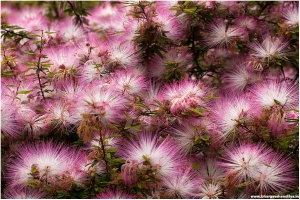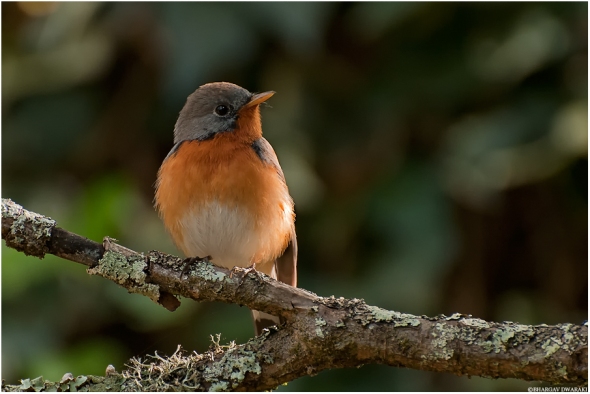New Life
For those of you who are following this blog, wondering if I’m still alive, let me dispel your doubts on the subject and tell you that I am and very much so! Alive and kicking for all the right reasons too! 🙂 The last seven months have been one hell of a ride and have resulted in my making a life changing decision. The decision being: I quit my day job and turned to a full-time photographer, freelancer and a traveler.
This is exactly what I have wished for all my life, but to say that it was an easy choice would be a far shot. After months of clocking in with the rest of the corporate world, wishing to be out in the wild while sitting in front of my computer, day after day, in anticipation of my next steady paycheck, lots of deliberation and debating with my family later, I realized the only thing left to do was to take that leap of faith. Sticking with a safe job is an easy decision, especially because it means a steadiness that is considered good based on the collective societal belief impressed upon us. Taking a risk on the other hand, comes with a risk. (Duh!) I am happier having taken this route as it means staying true to myself even if it means missing the perk of a fixed moolah at the end of each month and high speed internet acess. (I won’t lie, I dreadfully miss it.:P)
Living the life of a freelance photographer comes with its share of challenges. If I had imagined being self-employed would be tough, the first five months have asserted that through reality. Paying the bills is still a priority as is learning. In this quest, my aim is to get exposed to as many forms of the art as possible. My passion lies with wildlife photography, but I am also working in parallel on commercial photo shoots and travel photography. That being said, it is important to me that the aesthetic of this art is preserved irrespective of the forum.
For my first photo shoot, I had the opportunity of clicking an adorable baby girl, Sameksha and was rather pleased with how I did.
Also tried my hand at wedding photography for my cousin Prashant, who gave me my first camera. Although they liked my clicks, personally I felt I could have done better.
Another wedding assignment followed this and here my learning from the previous shoot, helped me do better.
I did an assignment for a leading travel firm to shoot hotels and resorts in Pondicherry, mangalore and Bangalore. It was fun to work and a great learning experience.
I ventured out into capturing portraits and here are a few clicks.
This month I had a chance to shoot at the Enchanted Valley Carnival where there were about 60 artists performing at Aamby Valley. The experience overall was very rewarding and I got to shoot some biggies like Indian Ocean, ATB and Taio Cruz etc. You can check out the pictures here.
Take a look at my website( http://www.bhargavshandilya.in ) here. The gallery is not fully up yet, but will approach completion in a few days time.
I am always open to feedback , so Feel free to leave your comments.
So if any of you are looking for a photographer don’t even consider going elsewhere. I’m your man! :D:D (All the publicity aside, I’m a really nice person to work with.:P)
If you like my work, then please do share it with your family and friends 🙂
Kashmir Flycatcher (Ficedula subrubra)
The Kashmir Flycatcher(Ficedula subrubra) is a small passerine bird in the flycatcher family Muscicapidae.
This is an insectivorous species which breeds in the north-west Himalayas in the Kashmir region. It is migratory and winters in the Western Ghats and in the hills of central Sri Lanka.
It is 13 cm long.The male has a grey-brown back with an orange-red throat, breast and flanks, bordered with black on the throat and breast. Females and first-winter birds have slightly browner upper parts, and the red of the underparts reduced to just a pinkish wash.
The Kashmir Flycatcher breeds in deciduous forest with dense undergrowth, nesting in a hole in a tree and laying 3-5 eggs which are incubated by the female. It winters in gardens, tea estates, forest edges, and open areas within forest, generally above 750 m.
The song is a short melodic sweet-eet sweet-eet-did-he, and the call is a sharp chak.
This migratory flycatcher is a vulnerable species with a decreasing population and breeding range, which is also severely fragmented as a result of the destruction of temperate mixed deciduous forests by commercial timber extraction, agriculture and livestock grazing.(Source – Wikipedia)
Both photos were taken in Ooty ,using Nikon D300s.Nikkor 70 – 300mm VR lens.
I had been to Ooty with Vinod during the last week of march. It was a good birding trip. We got to see this rare bird along with many endemic species(including Black chinned Laughing Trush or Nilgiri Laughing Trush ). I made some good images of Grey headed canary Flycatcher and Nilgiri Flycatcher (will post them soon) , I will definitely go back to photograph the endemics. We had gone in an open jeep and it was great, we had to embrace the scorching heat and rain!(will tell more about this later)
Have a Happy Weekend 🙂
Cheers,
Bhargav
Tickell’s Blue Flycatcher (Cyornis tickelliae)
The Tickell’s Blue Flycatcher (Cyornis tickelliae) is a small passerine bird in the flycatcher family. They are insectivorous species and are found in dense scrub to forest habitats.
It is a sparrow sized (14cm ) bird , it perches bolt upright a couple of meters from the ground,flicking its tail and uttering a sharp tick,tick from time to time.
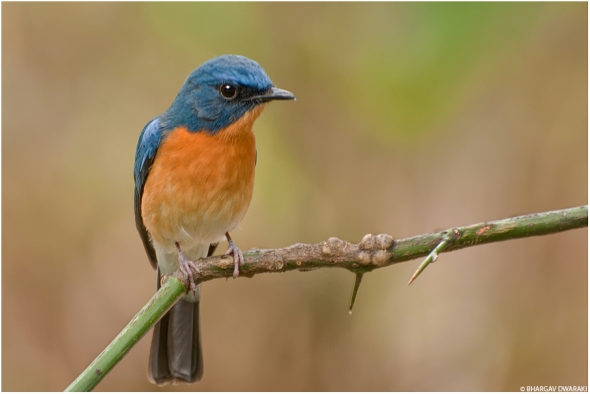 Tickell’s Blue Flycatcher
Tickell’s Blue Flycatcher
Male has the upper parts indigo blue and their forehead,supercilium and shoulders are azure blue , the throat and breast are orange – rufous and has white belly.Females are similar to male but are duller in color.
 Tickell’s Blue Flycatcher
Tickell’s Blue Flycatcher
They feed mainly by capturing insects in flight but their prey include other insects such as termites and earwigs that may be gleaned or picked from the ground.They have an unmistakable call which sounds tick – tick.( Source – Wikipedia and Handbook of the birds of India and Pakistan)
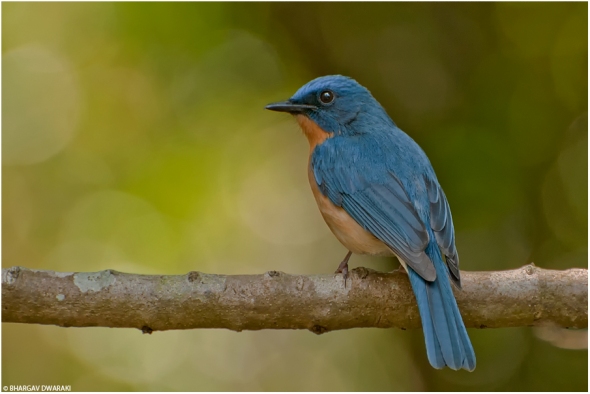 Tickell’s Blue Flycatcher
Tickell’s Blue Flycatcher
All 3 photos were taken in Nandi hills using Nikon D300s ,Nikkor 70 – 300mm VR lens.
Comments ,critics and suggestions are welcome 🙂
In the past 3 months I have made many visits to Nandi Hills and I Have struggled to photograph here because of the tricky light condition . Out of several visits I have made , only the last two were good in terms of photography and I learnt how to handle the camera in such condition.There is so much to learn!!And I am learning (slowly though). Saying that , every time I go to Nandi Hills I have a surprise waiting there each time. During each visit I get to see and learn something new , the last one being sighting of Pied Trush (Zoothera wardii) 🙂 . I really hope this continues 🙂
On a personnel note , I completed 23 years few days back and also completed 1.5 years in office. Office is frustrating like never before I think I was confident of doing something (in life) when I was jobless and sitting at home than now (while working). Hope things get better(Soon , Plz!!).
Cheers,
Bhargav
2012
2012 has been good. I bought my first Camera in August and have been doing quite well . When I started photography,I would just push the shutter button many times when I saw something, hoping that one would come out good. Now I use a more calculated approach, lots left to learn though .
I met some amazing people and made some good friends . I haven’t traveled and trekked ,as much as I wanted to but will make up for it this year 🙂
Well, 2012 has been the best year of my life so far. I hope 2013 gets better than that 🙂
Happy new year people , Thanks for the support .Have a great year ahead 🙂
 Happy 2013:)
Happy 2013:)
Common Kestrel (Falco tinnunculus) – Female
The Common Kestrel (Falco tinnunculus) is a bird of prey species belonging to the kestrel group of the falcon family Falconidae.It is a bird of farm land and open areas. It is known for the way it hovers above the ground , in search of prey.
It is a medium- sized (32- 29 cm ) falcon with long wings and tail.Plumage is light chestnut – brown with blackish spots on the upper-side and buff with narrow blackish streaks on the underside.The sexes are distinct, in males the rump and tail are bluish grey and unbarred,whereas in females they are brownish – red with dark barring.The head is grey in males and brown in females.( Source – Wikipedia)
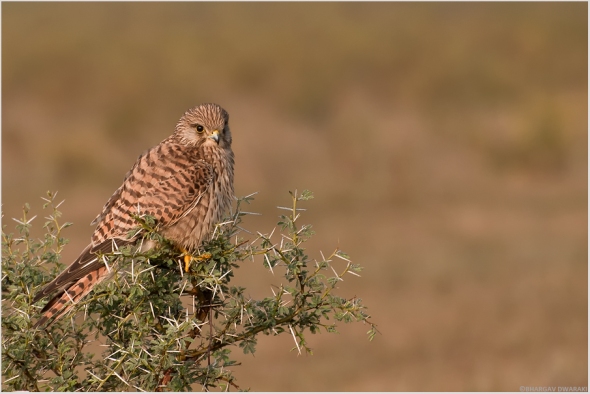 Common Kestrel
Common Kestrel
10th November, was a good day for me. Prior to this , I have tried almost a month to photograph this lady. Though I had managed to take few shots,I was not happy with it. On this day, I spent a good amount of time with her, I saw her Hoover , I saw her preen , I saw her catch insects. I managed to click shots which I wanted.
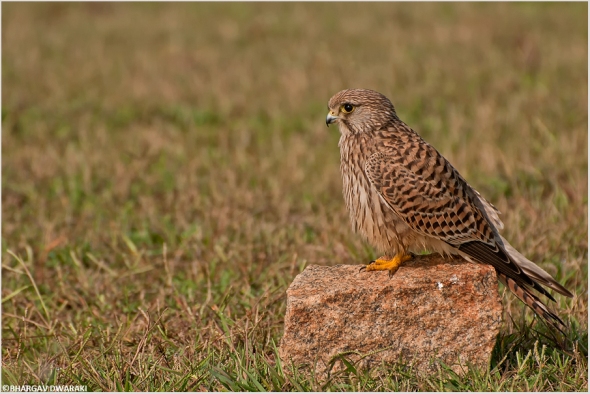 Ground Level shot of Common Kestrel
Ground Level shot of Common Kestrel
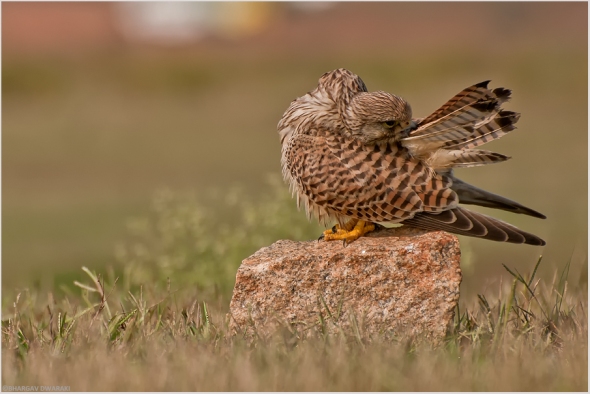 Common Kestrel – Preening
Common Kestrel – Preening
Please click HERE to read about Preening.
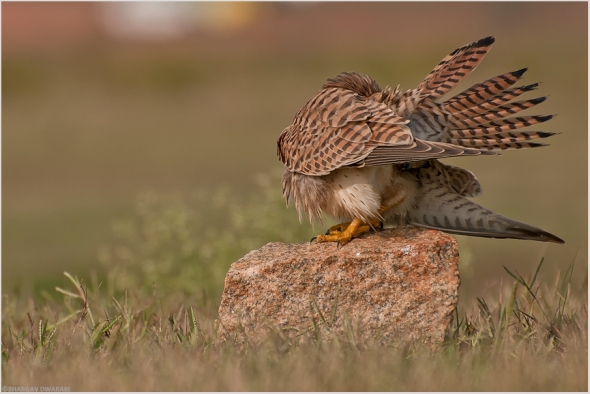 Lost in Preening
Lost in Preening
(Can you spot the head?)
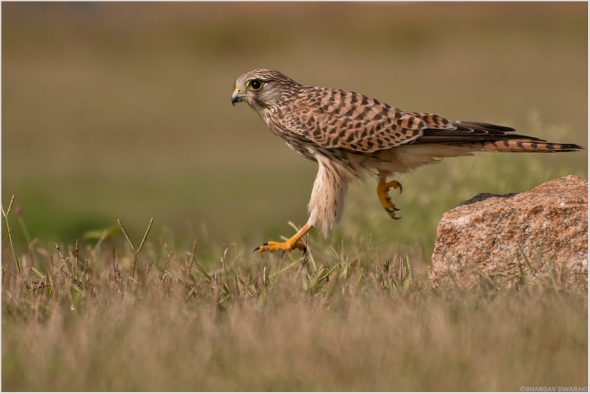 Jumping Kestrel
Jumping Kestrel
The below image was taken on 1st November and it is special to me. It was raining here in Bangalore for almost a week (remember Cyclone Nilam?), I had no plans of going for birdwatching or for photography as I thought it would rain , My friend (Hemanth) called me the previous night and asked if we can go, if there is no rain. On this day, it was drizzling but we thought it would stop and went ahead with the plan . But , the drizzle slowly picked up for our bad, added to that going in activa made it even more difficult for us. Mud went inside all possible parts it could go to and we had tough time cleaning it. It was still drizzling and was impossible to go back in the same path , we planned to take the other exit . On the way to exit , we stopped to take a photograph of a Paddy field Pipit but to our luck this beauty came and perched close to where we were.It was first time I was that close to any bird , I could see the details of it just with my eyes. I still cannot forget that eye contact. Got my first Portrait this day ! .Sometimes things just happen 🙂

A Portrait
The Kestrel feeds largely on small mammals, and small birds.Invertebrates are also very important components of the diet.Kestrels hunt by sight,upon spotting their quarry,they plunge to the ground ,seizing the prey with their talon.(Source – Arkive)
Kestrels, when hovering are able to stay still even in strong winds. I have seen one on top of Tadiyandamol hover against strong winds.
Nikon D300s,Nikkor 70-300mm VR lens , in Hessarghatta.
Hope you all had a great weekend ,Good Night 🙂
Egyptian Vulture (Neophron percnopterus)

Egyptian Vulture (Neophron percnopterus),also called the scavenger vulture. It has an unmistakable appearance, possessing white plumage with black feathers in the wings and tail . They have bare yellow face and the bill is large and narrow with a curved tip. The legs are pink in adults and grey in juveniles.Young birds are blackish or chocolate-brown with black and white patches.
 Egyptian
Egyptian
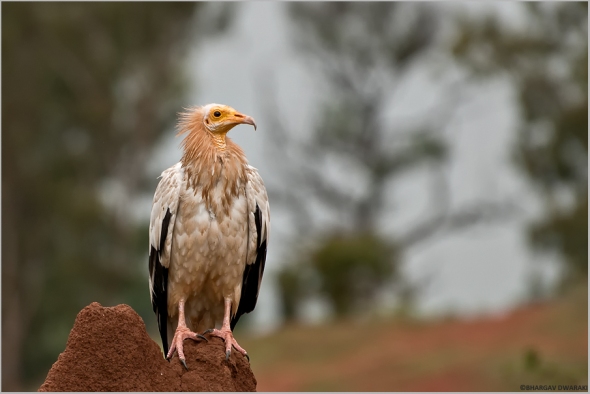
They are also called as Pharaoh’s Chicken
Egyptian Vultures feed mainly on carrion but are opportunistic and will prey on small mammals, birds, and reptiles.
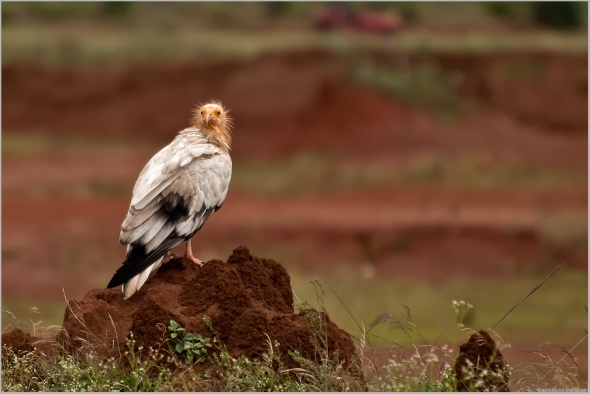
Conservation status of Egyptian Vulture is ENDANGERED , according to IUCN Red List.
The light was not on my side , this is the best I could do. Hope you like it.
Critics and comments are welcome 🙂
Light & Moss

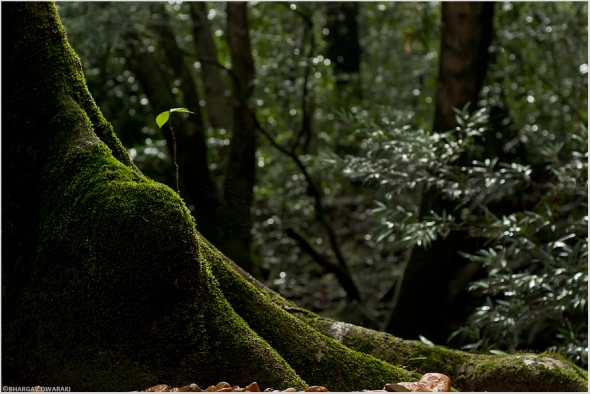 Light & Moss
Light & Moss
Mosses are small,soft plants .They commonly grow close together in clumps or mats in damp or shady locations.They do not have flowers or seeds,and their simple leaves cover the thin wiry stems.( Source – Wikipedia )
This picture also shows the lighting in Forest floor. The forest floor is usually shaded ,except where a canopy tree has fallen and created an opening. A small percentage of light that strikes the top of the forest penetrates to the forest floor.
Here, the moss is grown on buttress of tree. Will write more about buttress and canopy in coming posts 🙂
Taken in Agumbe , with Nikon D300s and my friends Nikkor 18- 55mm VR .
Cheers,
Bhargav
Photo Of The Day – Ashy – crowned Sparrow Lark (Female)

 Ashy – crowned Sparrow Lark – Female (Eremopterix griseus)
Ashy – crowned Sparrow Lark – Female (Eremopterix griseus)
Click HERE and HERE to see the photo of Ashy – crowned Sparrow Lark – Male.
Have a nice day 🙂
Red Wattled Lapwing (Vanellus indicus)

The Red Wattled Lapwing (Vanellus indicus) is a widespread resident in India. It is so called for the vivid red ,fleshly ,wrinkled skin or wattle ,in front of each eye.
 No Lapwing ,I didn’t do Anything!!!
No Lapwing ,I didn’t do Anything!!!
It is also known as the ‘Did you do it’ bird, as the bird’s call sounds like ” did you do it”.
Nikon D300s,Nikkor 70 – 300 mm VR, in Shantigrama.
Eurasian Roller (Coracias garrulous)

Eurasian Roller ( Coracias garrulous) also known as European rollers ,are migrants to our country and are near threatened species. They have colorful plumage .The head ,neck and underparts are light blue,while the upper parts are brownish -orange.A short ,thin black stripe runs through the eye.The tail is greenish- blue with a darker base.
Nikon D300s,Nikkor 70-300mm VR, f6.3,1/1000sec,ISO 400.
It feeds on invertebrates such as beetles, crickets, locusts, caterpillars, flies and spiders.
Nikon D300s,Nikkor 70-300mm VR, f6.3,1/800sec,ISO 400.
I first spotted this beautiful bird a day before this picture was shot but couldn’t capture the shot as too many people came in and frightened the bird away with all the activity 😦 . Luckily ,the very next day this bird flew to the place we were waiting .All we had to do was, just position our self at comfortable distance and click .
 Nikon D300s,Nikkor 70-300mm VR, f6.3,1/800sec,ISO 400.
Nikon D300s,Nikkor 70-300mm VR, f6.3,1/800sec,ISO 400.
Hope you like it 🙂
Meanwhile ,I trekked Tadiyandamol (Highest peak in Coorg range also 3rd highest peak in Karnataka) last weekend. It was brilliant, caught some good shots,will post them soon.
Have a nice day 🙂
Siberian Stonechat (Saxicola maurus ) Female

The Siberian Stonechat or Common Stonechat is a resident and a winter visitor to India.The Siberian Stonechat is insectivorous.It breeds in open rough scrub-land or rough grassland with scattered shrubs.The female has pale brown upper parts and head, white neck patches (not a full collar), and a pale, unstreaked pinkish-yellow rump.
All images shot with Nikon D300s,Nikkor 70-300mm VR. There was hardly anything behind the bird and hence,clean background.
Hope you liked it. Have a great Weekend .
Patterns 1

Patterns are present all around you ,all you need to do is recognize and enjoy them.
This was on last sunday morning trip to Hessarghatta. We (myself ,Dr Shekar and his friend Shivkumar) reached the place around 6.30 in the morning but to our bad luck it started raining and it poured heavily for a while. After the rain stopped (around 8.30 ), we had some good sightings among which Short toed Snake Eagle, Marsh Harrier, Common Kestrel were first timers for me. Got few good shots,will post it soon.
Can you guess what are these ?
Its a very easy guess. Let me know what you think. I will answer in my next post (am sure you will guess before that!)
Passion Flower (Passiflora foetida)

Passion flower ,kukkiballi(kannada) or love in a mist is a commonly seen weed flower from Central America.
The flower are white to pale cream coloured, about 5–6 cm diameter, It is able to trap insects on its bracts, which exude a sticky substance that also has digestive enzymes. This minimizes predation on young flowers and fruits.It is currently considered as protocarnivorous plant.(Refference – Wikipedia)
Ashy-crowned Sparrow Lark (Male) (Eremopterix grisea)

Ashy – crowned Sparrow Lark (Eremopterix griseus) is a lovely, small bird (12cm) about the size of sparrow.It is also known as Ashy – crowned Finch Lark or Black-bellied Finch-Lark.It is a bird of open dry habitat.The males are marked with a contrasting black and white face pattern,females are sandy brown.
Photo Of The Day – Egret about to take Off

Egret’s are one of the best subjects to learn new techniques in photography as they can be easily spotted and with little patience ,one can approach and move closer to them. I have applied ND filter while converting into Black n White , Shot with Nikon D300s ,Nikkor 70-300mm VR , in Shanthigrama.
I have applied ND filter while converting into Black n White , Shot with Nikon D300s ,Nikkor 70-300mm VR , in Shanthigrama.
Hope you liked it .
Good night 🙂
Black Drongo (IMMATURE)

Hi,
Here is the image of Black Drongo (Immature), which I captured yesterday in Hessarghatta, Bangalore.
Black Drongo, Dicrurus macrocercus is also called the King Crow. It is a fairly common and residential breeder in India.Adult has glossy blue-black or green-black plumage,Tail is long and deeply forked, and curves out at the end of outer tail feathers. Head is black, with only very small white patch at bill’s commissures. Bill is black. Eyes are reddish. Legs and feet are dark grey.
Juvenile is browner, with white tips to flanks and belly feathers, can be mistaken for the White – bellied drongo. It has shorter tail than adults.
Black Drongo feeds mainly on insects such as ants and termites and crickets, beetles, bees, and butterflies.They are quite territorial,fearless and aggressive.
Green Bee Eater in Rain

This weekend has been the most unproductive one in a long time!!! It was pouring in Bangalore so I thought ill head to my native (Shanthigrama) and try something out here.But to my bad luck it started raining here as well .Here is the picture of a Green Bee eater in rain which I had taken here in Shanthigrama, last month.
The Green Bee-eater, Merops orientalis, (also known as Little Green Bee-eater) is a near passerine bird in the bee – eater family.They breed in South-eastern Asia, and seen during the season in most places in peninsular India.
It is a richly coloured slender bird. It is about 9 inches (16–18 cm) long with about 2 inches made up by the elongated central tail-feathers. The entire plumage is bright green and tinged with blue especially on the chin and throat. The crown and upper back tinged with golden rufous. The flight feathers are rufous washed with green and tipped with blackish. A fine black line runs in front of and behind the eye. The iris is crimson and the bill is black while the legs are dark grey.
Bee-eaters predominantly eat insects, especially bees, wasps and ants, which are caught in the air by sorties from an open perch. Before swallowing prey, a bee-eater removes stings and breaks the exoskeleton of the prey by repeatedly thrashing it on the perch.
Hope you like it.
